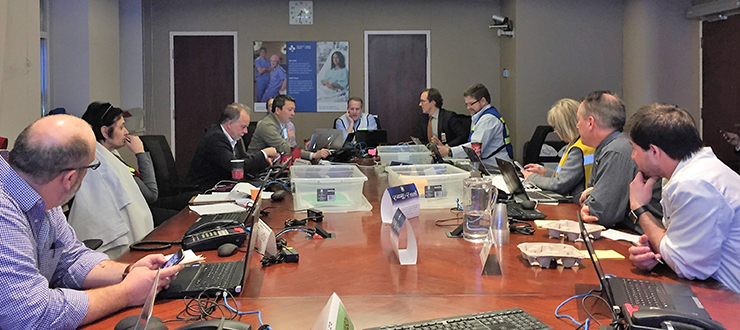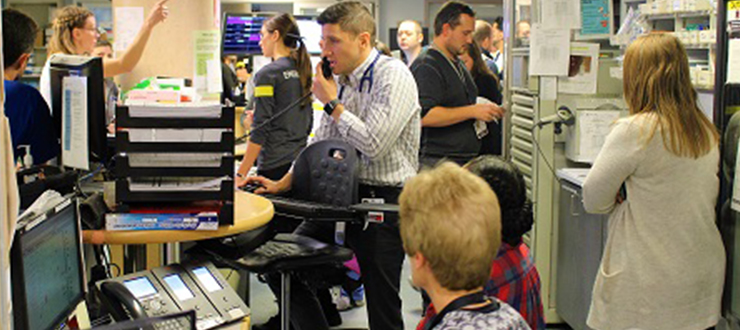
Over the past few years, the Emergency Management team has revamped the corporate Code Orange plan and has run regular training exercises to test the plan.
Late in the afternoon of Friday, January 11, staff at the Civic Campus Emergency Department started hearing word of a serious collision at nearby Westboro bus station.
A call to Ottawa Paramedic Services dispatch confirmed the news, and it became clear that trauma patients would soon arrive at the Civic Campus. The hospital declared a Code Orange, and launched its Emergency Operations Centre to coordinate the response.
“Everyone just stayed. We never had to say ‘stick around’ to our residents. They just did.”
Staff members who should have been finishing a long day settled in to stay for the evening, while staff who had been planning to work the evening shift headed in early. Some who had already left for the day – including Trauma Medical Director Dr. Jacinthe Lampron – turned around to come back. Many others had heard or seen media reports and called to see how they could help.
“Everyone just stayed,” said Dr. Joe Pagliarello about the ICU team. “We never had to say ‘stick around’ to our residents. They just did. It was an opportunity to do some good, to be part of a team.”
Within minutes, response teams from all over the hospital converged on the Emergency Department. Disaster equipment carts were quickly deployed. Pharmacy and transfusion medicine staff took their posts in Emergency.
“By the time the first trauma patient arrived, we had mobilized eight complete trauma teams outfitted with emergency physicians, trauma surgeons, anesthesiologists, respiratory therapists, nurses and plenty of blood,” remarked Dr. Mike Rubin, an emergency physician who supported Department Head Dr. Guy Hebert with operations. “It was impressive how many trauma specialists assembled with such short notice late on a Friday afternoon.”
Meanwhile, Civic Campus Operating Room Manager Joanna Schubert had to ensure that the operating rooms had all the staff and equipment they would need for the long night to come. Eight operating rooms – six more than a normal Friday night – were staffed to accommodate the incoming patients. Each operating room had a vascular and orthopaedic surgeon working on one patient, an unusual setup used only in multi-system traumas.

Chief Operating Officer Cameron Love (centre) led the Incident Management team of senior managers, which coordinates the hospital’s emergency response.
While the clinical teams worked hard to save lives, a small army of transportation workers, personal care attendants and housekeepers stood by, ready to clean rooms, run blood samples to the lab, and take patients to CT scans or the Operating Room.
Staff used more than 150 units of blood and blood products over the course of the night.
As the Emergency Department and the Operating Rooms took the initial influx of patients, units across the hospital acted quickly to provide support. When the Code was declared, there were roughly 100 patients in the Civic Emergency Department, including 24 admitted patients. Some were moved to other units, while some were transferred to the General Campus Emergency Department.
Throughout the evening, Contact Centre agents, volunteers and security personnel directed anxious families to the Family Information and Support Centre set up by Social Work. There, social workers and spiritual care providers spent hours with families, providing them with as much information as possible and offering support.
Katherine Cotton, Chair of the hospital’s Board of Governors, wrote in a letter after the event that the staff’s response was tremendous.
“The compassion and the extraordinary level of skill and composure shown by all the physicians, nurses, administrators and each and every one of the support staff on the front lines … were nothing short of remarkable, yet typical, of the exceptional work that is done each and every day,” she wrote.
Preparing for disaster: Code Orange exercise gave teams valuable practice
The January 11 bus collision marked the first time the hospital has called a Code Orange since the September 2013 bus-train collision.
Many of the staff members involved in the January 11 response credit the hospital’s commitment to Emergency Management with improving its response in the time since the last Code Orange.
Over the past few years, in collaboration with departments from across the hospital, the Emergency Management team has revamped the corporate Code Orange plan and has run regular training exercises to test the plan.

The largest of these exercises, a simulated response to a mass casualty event, took place in November.
Dr. Adnan Sheikh, head of Emergency Radiology, described how useful the exercise was: “It was important to have had, fresh in back of your mind, that really helped. That was the preparatory course and Friday was the exam.”

Support patient care and research at
The Ottawa Hospital


 To reset, hold the Ctrl key, then press 0.
To reset, hold the Ctrl key, then press 0.